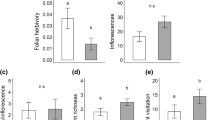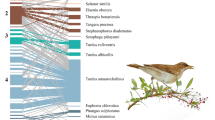Abstract
Spatial variation in plant community composition is an important driver of variation in susceptibility to herbivores. In close proximity, certain neighbors can attract or repel herbivores to a focal plant (“associational effects”). Neighboring plants may also compete for resources, modifying their phenotype in ways that affect susceptibility to herbivores. To test whether and how competition contributes to associational effects, we manipulated the sharing of belowground resources among plant neighbors (spotted Joe Pye weed and common boneset) that serve as alternate hosts for an herbivorous beetle. In the field, the beetle Ophraella notata laid more eggs and inflicted more damage on plants of both species that were released from belowground competition with neighbors. Competition also weakened the effects of neighbor identity during field trials, reducing associational susceptibility. When beetles were forced to choose between the two host species in cage trials, competition again reduced beetle use of Joe Pye weed as a secondary host. To test the role of plant traits related to herbivore defense and nutrition, we quantified leaf protein, specific leaf area, and trichomes, and conducted behavioral assays on leaf disks. Beetles did not distinguish between Joe Pye weed treatments at the leaf disk level, and competition did not impact specific leaf area and protein. Trichome density was higher in both species in the preferred treatment. Overall, our results suggest that belowground interactions between plants may mediate the strength of associational effects, as secondary hosts become more attractive when released from competition with primary host plants.





Similar content being viewed by others

Data availability
Study data are available from the corresponding author on reasonable request.
Code availability
Code used in analysis is available from the corresponding author on reasonable request.
References
Agrawal AA, Hastings AP, Johnson MTJ, Salminen J-P (2012) Insect herbivores drive real-time ecological and evolutionary change in plant populations. Science 338:113–116
Ali MI, Bi JL, Young SY, Felton GW (1999) Do foliar phenolics provide protection to Heliothis virescens from a Baculovirus? J Chem Ecol 25:2193–2204
Andow DA (1991) Vegetational diversity and arthropod population response. Annu Rev Entomol 36:561–586
Atsatt PR, O’Dowd DJ (1976) Plant defense guilds. Science 193:24–29
Barbosa P, Hines J, Kaplan I, Martinson H, Szczepaniec A, Szendrei Z (2009) Associational resistance and associational susceptibility: having right or wrong neighbors. Annu Rev Ecol Evol Syst 40:1–20
Boege K (2010) Induced responses to competition and herbivory: natural selection on multi-trait phenotypic plasticity. Ecology 91:2628–2637
Borer ET, Seabloom EW, Gruner DS et al (2014) Herbivores and nutrients control grassland plant diversity via light limitation. Nature 508:517–520
Brooks ME, Kristensen K, van Benthem KJ et al (2017) glmmTMB Balances speed and flexibility among packages for zero-inflated generalized linear mixed modeling. R J 9:378–400
Campo J, Dirzo R (2003) Leaf quality and herbivory responses to soil nutrient addition in secondary tropical dry forests of Yucatan, Mexico. J Trop Ecol 19:525–530
Campos ML, Yoshida Y, Major IT et al (2016) Rewiring of jasmonate and phytochrome B signalling uncouples plant growth-defense tradeoffs. Nat Commun 7:12570
Carvalho S, Macel M, Schlerf M et al (2013) Changes in plant defense chemistry (pyrrolizidine alkaloids) revealed through high-resolution spectroscopy. ISPRS J Photogramm Remote Sens 80:51–60
Castagneyrol B, Giffard B, Péré C, Jactel H (2013) Plant apparency, an overlooked driver of associational resistance to insect herbivory. J Ecol 101:418–429
Center TD, Van TK, Dray FA Jr et al (2005) Herbivory alters competitive interactions between two invasive aquatic plants. Biol Control 33:173–185
Champagne E, Tremblay J-P, Côté SD (2016) Spatial extent of neighboring plants influences the strength of associational effects on mammal herbivory. Ecosphere 7:e01371
Chen F, Liu X, Zhou SR (2019) Indirect effect of nitrogen enrichment modified invertebrate herbivory through altering plant community composition in an alpine meadow. Journal of Plant Ecology 12:693–702
Cipollini D (2004) Stretching the limits of plasticity: can a plant defend against both competitors and herbivores? Ecology 85:28–37
Cipollini DF, Bergelson J (2001) Plant density and nutrient availability constrain constitutive and wound-induced expression of trypsin inhibitors in Brassica napus. J Chem Ecol 27:593–610
Colegate SM, Upton R, Gardner DR, Panter KE, Betz JM (2018) Potentially toxic pyrrolizidine alkaloids in Eupatorium perfoliatum and three related species. Implications for herbal use as boneset. Phytochem Anal 29:613–626
Craine JM, Dybzinski R (2013) Mechanisms of plant competition for nutrients, water and light. Funct Ecol 27:833–840
de Vries J, Evers JB, Poelman EH (2017) Dynamic plant–plant–herbivore interactions govern plant growth-defence integration. Trends Plant Sci 22:329–337
Eigenbrode SD, Birch ANE, Lindzey S, Meadow R, Snyder WE (2016) A mechanistic framework to improve understanding and applications of push-pull systems in pest management. J Appl Ecol 53:202–212
Feeny P (1970) Seasonal changes in oak leaf tannins and nutrients as a cause of spring feeding by winter moth caterpillars. Ecology 51:565–581
Felton GW (1996) Nutritive quality of plant protein: sources of variation and insect herbivore responses. Arch Insect Biochem Physiol. https://doi.org/10.1002/(SICI)1520-6327(1996)32:1%3c107::AID-ARCH7%3e3.0.CO;2-X
Fernández-Milmanda GL, Crocco CD, Reichelt M et al (2020) A light-dependent molecular link between competition cues and defence responses in plants. Nat Plants 6:223–230
Floater GJ, Zalucki MP (2000) Habitat structure and egg distributions in the processionary caterpillar Ochrogaster lunifer: lessons for conservation and pest management. J Appl Ecol 37:87–99
Fox J, Weisberg S (2019) An R Companion to Applied Regression, Third. Sage, Thousand Oaks, CA
Funk DJ, Futuyma DJ, Orti G, Meyer A (1995) A history of host associations and evolutionary diversification for Ophraella (Coleoptera: Chrysomelidae): New evidence from mitochondrial DNA. Evolution 49:1008–1017
Futuyma DJ (1990) Observations on the taxonomy and natural history of Ophraella Wilcox (Coleoptera: Chrysomelidae), with a description of a new species. J N Y Entomol Soc 98:163–186
Getman-Pickering ZL, Campbell A, Aflitto N, Grele A, Davis JK, Ugine TA (2020) LeafByte: a mobile application that measures leaf area and herbivory quickly and accurately. Methods Ecol Evol 11:215–221
Glassmire AE, Carson WP, Smilanich AM, et al (2023) Multiple and contrasting pressures determine intraspecific phytochemical variation in a tropical shrub. Oecologia 201:991–1003Haberlandt G (1914) Physiological Plant Anatomy. Macmillan and Company, limited
Hahn PG, Keefover-Ring K, Nguyen LMN, Maron JL (2021) Intraspecific correlations between growth and defense vary with resource availability and differ within- and among-populations. Funct Ecol. https://doi.org/10.1111/1365-2435.13878
Hambäck PA, Inouye BD, Andersson P, Underwood N (2014) Effects of plant neighborhoods on plant–herbivore interactions: resource dilution and associational effects. Ecology 95:1370–1383
Hanley ME, Lamont BB, Fairbanks MM, Rafferty CM (2007) Plant structural traits and their role in anti-herbivore defence. Perspect Plant Ecol Evol Syst 8:157–178
Hensel A, Maas M, Sendker J et al (2011) Eupatorium perfoliatum L.: phytochemistry, traditional use and current applications. J Ethnopharmacol 138:641–651
Herms DA, Mattson WJ (1992) The dilemma of plants - to grow or defend. Q Rev Biol 67:283–335
Hol WHG (2011) The effect of nutrients on pyrrolizidine alkaloids in Senecio plants and their interactions with herbivores and pathogens. Phytochem Rev 10:119–126
Holmes KD, Agrawal AA (2021) Induced resistance mitigates the effect of plant neighbors on susceptibility to herbivores. Ecosphere 12:. https://doi.org/10.1002/ecs2.3334
Holmes KD, Blubaugh CK (In press) Unpacking inconsistency in benefits of plant diversity across trophic levels: Lessons from fifteen global syntheses. Quarterly Review of Biology
Huang W, Gfeller V, Erb M (2019) Root volatiles in plant-plant interactions II: Root volatiles alter root chemistry and plant-herbivore interactions of neighbouring plants. Plant Cell Environ 42:1964–1973
Izaguirre MM, Mazza CA, Biondini M, Baldwin IT, Ballaré CL (2006) Remote sensing of future competitors: impacts on plant defenses. Proc Natl Acad Sci USA 103:7170–7174
Johnson SN, Waterman JM, Wuhrer R et al (2021) Siliceous and non-nutritious: nitrogen limitation increases anti-herbivore silicon defences in a model grass. J Ecol 109:3767–3778
Jorge SM, Carlos CM, Betty BB et al (1988) Patterns of oviposition by Sandia xami (Lepidoptera, Lycaenidae) in relation to food plant apparency. Ecol Entomol 13:71–79
Karban R (1997) Neighbourhood affects a plant’s risk of herbivory and subsequent success. Ecol Entomol 22:433–439
La Pierre KJ, Smith MD (2016) Soil nutrient additions increase invertebrate herbivore abundances, but not herbivory, across three grassland systems. Oecologia 180:485–497
Lenth R (2022) Emmeans: Estimated Marginal Means, aka Least-Squares Means. R package version 2.20–23. https://doi.org/10.18637/jss.v069.i01
Letourneau DK, Armbrecht I, Rivera BS et al (2011) Does plant diversity benefit agroecosystems? A synthetic review. Ecol Appl 21:9–21
Mattson WJ (1980) Herbivory in relation to plant nitrogen content. Annu Rev Ecol Syst 11:119–161
McGuire R, Agrawal AA (2005) Trade-offs between the shade-avoidance response and plant resistance to herbivores? Tests with mutant Cucumis sativus. Funct Ecol 19:1025–1031
Mutz J, Heiling JM, Paniagua-Montoya M, Halpern SL, Inouye BD, Underwood N (2022) Some neighbours are better than others: variation in associational effects among plants in an old field community. J Ecol 110:2118–2131
Otway SJ, Hector A, Lawton JH (2005) Resource dilution effects on specialist insect herbivores in a grassland biodiversity experiment. J Anim Ecol 74:234–240
Panda S, Kazachkova Y, Aharoni A (2021) Catch-22 in specialized metabolism: balancing defense and growth. J Exp Bot 72:6027–6041
Pérez-Harguindeguy N, Díaz S, Vendramini F, Cornelissen JHC, Gurvich DE, Cabido M (2003) Leaf traits and herbivore selection in the field and in cafeteria experiments. Austral Ecol 28:642–650
R Core Team (2022) R: A language and environment for statistical computing
Root RB (1973) Organization of a plant-arthropod association in simple and diverse habitats: the fauna of collards (Brassica oleracea). Ecol Monogr 43:95–124
Schillinger JA, Gallun RL (1968) Leaf Pubescence of Wheat as a Deterrent to the Cereal Leaf Beetle, Oulema melanopus. Ann Entomol Soc Am 61:900–903
Schmidt GJ, Schilling EE (2000) Phylogeny and biogeography of Eupatorium (Asteraceae:Eupatorieae) based on nuclear its sequence data. Am J Bot 87:716–726
Stamp N (2003) Out of the quagmire of plant defense hypotheses. Q Rev Biol 78(1):23–55
Underwood N, Inouye BD, Hambäck PA (2014) A conceptual framework for associational effects: when do neighbors matter and how would we know? Q Rev Biol 89:1–19
Waring GL, Cobb NS (1992) The impact of plant stress on herbivore population dynamics. Volume IV. CRC PressZettlemoyer MA (2022) Leaf traits mediate herbivory across a nitrogen gradient differently in extirpated vs. extant prairie species. Oecologia 198:711–720
Acknowledgements
The authors would like to thank Tyler Coverdale for helpful feedback on the experimental design, Amy Hastings for assistance with leaf trait analysis methods, and undergraduate researcher Lei Lei Wu for her help with experimental setup and data collection.
Funding
Experiments were funded by the Cornell Andrew W. Mellon Student Research Grant and the Paul P. Feeny Graduate Student Research Fund.
Author information
Authors and Affiliations
Contributions
KH formulated the research question and developed the experimental design with EM. Experiments were performed by KH, with leaf tissue analyses contributed by ZG-P. Data analysis was performed by KH under the guidance of EM and AGP. KH and AGP wrote the manuscript, with feedback from EM and ZG-P.
Corresponding author
Ethics declarations
Conflict of interest
The authors declare they have no conflicts of interest.
Ethics approval
Not applicable.
Consent to participate
Not applicable.
Consent for publication
Not applicable.
Additional information
Communicated by Merijn Kant.
Supplementary Information
Below is the link to the electronic supplementary material.
Rights and permissions
Springer Nature or its licensor (e.g. a society or other partner) holds exclusive rights to this article under a publishing agreement with the author(s) or other rightsholder(s); author self-archiving of the accepted manuscript version of this article is solely governed by the terms of such publishing agreement and applicable law.
About this article
Cite this article
Holmes, K.D., Getman-Pickering, Z.L., Mudrak, E.L. et al. Plant susceptibility to a shared herbivore is reduced by belowground competition with neighbors. Oecologia 203, 113–124 (2023). https://doi.org/10.1007/s00442-023-05454-2
Received:
Accepted:
Published:
Issue Date:
DOI: https://doi.org/10.1007/s00442-023-05454-2



